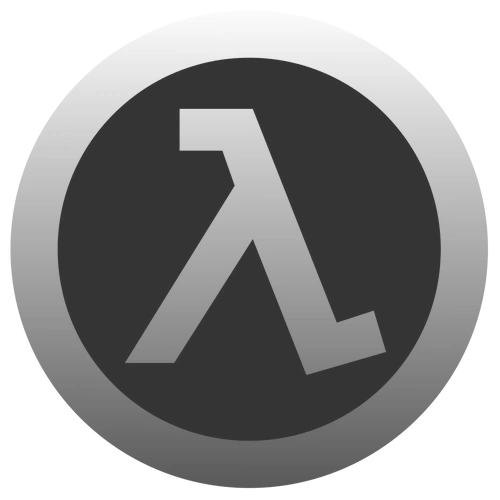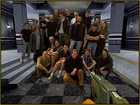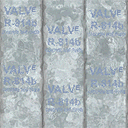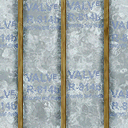Valve Corporation, often referred to as Valve Software or simply Valve, and stylized as VALVE, is an American video game and digital distribution developer based in Bellevue, Washington.[2] Their first game, Half-Life, was highly acclaimed and since they have gone on to develop more franchises, including Left 4 Dead and Team Fortress, as well as Portal, all of which are first-person shooters.
Valve also developed the popular Steam content delivery client, which is now the market leader with over 1,100 games available, and with 70% of the market share.[3] Valve releases all of their games via Steam.
History

The Mr. Valve logo used from 1998 (Half-Life) to 2005 (Xbox version of Half-Life 2).
Valve was founded on August 24, 1996[4][5] by two former Microsoft employees, Gabe Newell and Mike Harrington. They originally started out as an L.L.C. company based in Kirkland, Washington, however, after incorporation in 2003, Valve moved from Kirkland to Bellevue.
Following the success of Half-Life, the Valve team expanded their portfolio, creating mods, spin-offs, and sequels. Valve has accumulated rights to at least six different series which include Half-Life, Team Fortress, Portal, Counter-Strike, Left 4 Dead and Day of Defeat. Valve is most noted for its support of the modding community. In fact, its games Counter-Strike, Team Fortress, and Day of Defeat, all started out as third-party mods before becoming full-fledged games. Valve distributes some community mods on their content delivery system, Steam.
Valve's answering machine message by Harry S. Robins
On January 10, 2008, Valve announced the acquisition of Turtle Rock Studios,[6] who previously worked with Valve on Counter-Strike: Condition Zero, porting the Counter-Strike to the Xbox and creating various maps for Counter-Strike: Source. They also worked on Left 4 Dead, providing an advanced AI system.
Valve also notably headed PowerPlay, a technological initiative designed to decrease latency whilst playing online computer games, but after 12 months the project was quietly abandoned.
Products and franchises
List of games
- Half-Life (1998)
- Team Fortress Classic (1999)
- Half-Life: Opposing Force (1999)
- Deathmatch Classic (2000)
- Ricochet (2000)
- Counter-Strike (2000)
- Half-Life: Blue Shift (2001)
- Day of Defeat (2003)
- Counter-Strike: Condition Zero (2004)
- Half-Life: Source (2004)
- Counter-Strike: Source (2004)
- Half-Life 2 (2004)
- Half-Life 2: Deathmatch (2004)
- Half-Life Deathmatch: Source (2005)
- Day of Defeat: Source (2005)
- Half-Life 2: Lost Coast (2005)
- Half-Life 2: Episode One (2006)
- Half-Life 2: Episode Two (2007)
- Portal (2007)
- Team Fortress 2 (2007)
- Left 4 Dead (2008)
- Left 4 Dead 2 (2009)
- Alien Swarm (2010)
- Portal 2 (2011)
- Counter-Strike: Global Offensive (2012)
- Dota 2 (2013)
Notable games / series
Half-Life series
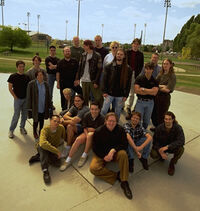
Picture of the Half-Life team around 1998, from the Sierra Studios E3 1998 Press Kit.
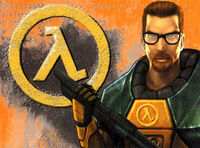
Half-Life box art.

Possible blueprint from offices at Valve featured in the background images of the Half-Life instruction manual, presented like a BMRF blueprint.
Valve began working on the first game of the Half-Life series soon after the company's formation, and settled on a concept for a horror-themed 3D action game, using the Quake engine as licensed by id Software. Half-Life was a hit at the 1997 E3 convention, where its animation system and artificial intelligence were demonstrated. The game's success led to its first expansion pack, Half-Life: Opposing Force, which was developed by Gearbox Software, a company based in Plano, Texas. Randy Pitchford, founder of Gearbox, said in an interview that he believed Valve gave them the opportunity to produce a sequel to Half-Life to allow Valve to focus on future titles. The game was demonstrated at the 1999 E3 convention, where new locations, characters, and the storyline were revealed.
On November 16, 2004,[7] Half-Life 2, the sequel to the original game, was released. Following its release, the series was continued using a trilogy of episodic games. Half-Life 2: Episode One was the first of these, set around City 17 after the events of the original game, in which Gordon Freeman and Alyx Vance must attempt to escape the city after a dark energy reactor core they damaged at the end of Half-Life 2 threatens to destroy the city. It was released on June 1, 2006,[8] and introduced several new graphical effects including new lighting features and facial animation.
The second episodic game, Half-Life 2: Episode Two, was released on October 10, 2007,[9] and continues the story soon after where Episode One ended. This episode focuses on expansive environments, travel, and less linear play. It was released in The Orange Box along with Half-Life 2, Episode One, Portal, and Team Fortress 2.
Half-Life 2: Episode Three is slated to be the third and final installment of the episodic expansions.[10] The game has, presumably, been in development since some time in 2008, since concept art surfaced in July of that year.[11] However, besides passing comments when pressed in interviews, very little is known about the game.
Day of Defeat
Day of Defeat began as a third-party Half-Life mod in 2000. Later, the DoD team joined Valve Software and produced a standalone version published through Activision. Day of Defeat was officially released on May 1, 2003.[12] It features multiplayer gameplay that takes place during the European Theatre of World War II. It was converted over to the Steam delivery system in version 1.1 and now requires Steam to play.
Day of Defeat: Source, an updated version of DoD, which moved Day of Defeat from GoldSrc to the Source engine, was released on September 26, 2005.[13] As in the original, it features multiplayer game-play.
Counter-Strike series
Counter-Strike, released on September 15, 2003,[14] is a multiplayer game in which players join either the terrorist or counter-terrorist team. Counter-Strike was originally developed as a Half-Life modification. It soon grew into a commercial mod and was later advertised as a separate game in itself. It still uses and runs on the Half-Life game engine, GoldSrc.
The follow-up to Counter-Strike, Counter-Strike: Condition Zero, was released on March 20, 2004,[15] and runs on GoldSrc. Like its predecessor, Condition Zero is also a multiplayer game, with an added single-player mode. Development of Condition Zero began in 2000 by Rogue Entertainment. However, Rogue's producer for the game, Jim Molinet, moved to Sony, therefore leaving the development up to Valve. Later, development was given to Gearbox so that Valve could focus on the development of Team Fortress 2.
Counter-Strike: Source is a complete remake of Counter-Strike using the Source engine. As in the original, Counter-Strike: Source pits a team of counter-terrorists against a team of terrorists in a series of rounds. It was initially released as a beta to members of the Valve Cyber Café Program on August 11, 2004.[16][17] On August 18, 2004 the beta was released to owners of Counter-Strike: Condition Zero and to those who had received a Half-Life 2 voucher bundled with some ATi Radeon video cards.[18]
Team Fortress 2
Team Fortress Software, the creators of the mod Team Fortress, were employed by Valve in 1998,[19] and shortly thereafter began work on Team Fortress 2. To tide fans over, a port of Team Fortress was made called Team Fortress Classic. Finally, after a long development period, Team Fortress 2 was released on October 10, 2007[20] as a standalone product via Steam as well as in The Orange Box. The game became free-to-play on Steam on June 23, 2011. TF2's gameplay is focused around two opposing teams battling in rounds to achieve a target. These teams, Reliable Excavation & Demolition (RED) and Builders League United (BLU), represent two holding corporations that between them secretly control every government on the planet.[21] Players can choose to play as one of nine classes in these teams, each with his own unique strengths and weaknesses.
Portal series
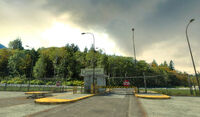
Aperture Science Enrichment Center entrance.
Portal is Valve's professionally-developed spiritual successor to the freeware game project Narbacular Drop, the 2005 independent game released by students of DigiPen, who are now all employed at Valve.[22][23] Released on October 10, 2007,[24] the game was only available as part of The Orange Box, however after its success it is now available separately on Steam. The game follows Chell, a test subject in the Aperture Science Enrichment Center, who must use the Handheld Portal Device to navigate through nineteen Test Chambers, all the while being guided by a sinister AI who offers "consoling" advice.
On March 1, 2010, Portal was updated to tie in with an alternate reality game, which was eventually revealed to be promoting a full sequel, Portal 2. Portal 2 was officially announced on March 5, 2010[25] and was confirmed to be a full-priced standalone game, taking place in an unknown area of Aperture Science Enrichment Center.
Left 4 Dead series
Using the Source engine, Valve set out to make a horror film inspired game that merges single-player games' character-driven narrative structure with multiplayer games' social interaction and high replayability.[26] From that idea, Left 4 Dead was born. When making Left 4 Dead, many aspects of the Source engine were changed, such as more realistically portraying hair and clothing, and improved physics interaction with enemies. The Source engine was also improved to have smarter AI, lighting, cinematic visual effects, and dynamic color correction. After a three-year development process, Left 4 Dead was released on November 17, 2008.[27] The game is set during the aftermath of an apocalyptic zombie pandemic, and pits its four protagonists against hordes of the infected.
Left 4 Dead 2, the sequel to the original game, was released on November 16, 2009.[28] Like the original, Left 4 Dead 2 is set during the aftermath of an apocalyptic pandemic, and focuses on four new survivors fighting against hordes of the infected. Development for Left 4 Dead 2 started shortly after the release of the first game. Valve built on ideas from the development team to make the next game "bigger and better".[29]
Steam

The Steam logo.
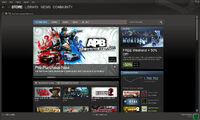
The Steam store view.
Valve announced its Steam content delivery system in 2002. At the time, it looked to be a method of streamlining the patch process common in online computer games. Steam was later revealed as a replacement for much of the dated framework of WON and Half-Life multiplayer and also as a distribution system for entire games since 2005. It was released on September 12, 2003.[30]
As part of Steam, Valve developed the Valve Anti-Cheat system, an anti-cheat solution that prevented players from changing the game code to gain an advantage over other players. It is now implemented as a part of Steamworks, a publishing suite that gives developers access to every component of Steam.[31]
Lawsuits
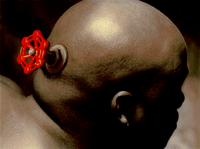
The Mr. Valve logo used since 2006 (Episode One).
Between 2002 and 2005, Valve was involved in a complex legal showdown with its publisher, Vivendi Universal (under Vivendi's brand Sierra Entertainment). It officially began on August 14, 2002 when Valve sued Sierra for copyright infringement, alleging that the publisher illegally distributed copies of their games to Internet cafes. They later added claims of breach of contract, accusing their publisher of withholding royalties and delaying the release of Counter-Strike: Condition Zero until after the holiday season.
Vivendi fought back, saying that Gabe Newell and marketing director Doug Lombardi had misrepresented Valve's position in meetings with the publisher. Vivendi later counter-sued, claiming that Valve's Steam content distribution system attempted to circumvent their publishing agreement. Vivendi sought intellectual property rights to Half-Life and a ruling preventing Valve from using Steam to distribute Half-Life 2.
On November 29, 2004, Judge Thomas S. Zilly of the U.S. Federal District Court in Seattle, WA ruled in favor of Valve. Specifically, the ruling stated that Vivendi Universal and its affiliates (including Sierra) were not authorized to distribute Valve games, either directly or indirectly, through Internet cafés to end users for pay-to-play activities pursuant to the parties' current publishing agreement. In addition, Judge Zilly ruled that Valve could recover copyright damages for infringements without regard to the publishing agreement's limitation of liability clause.[32]
On April 29, 2005, Valve posted on the Steam website that the two companies had come to a settlement in court.[33]
On July 18, 2005, Electronic Arts announced that they would be teaming up with Valve in a multi-year deal to distribute their games, replacing Vivendi Universal from 2005 onwards.[34]
In April 2009, Valve sued Activision Blizzard, which acquired Sierra Entertainment after a merger with its parent company, Vivendi Universal Games. Activision had allegedly refused to honor the Valve vs Vivendi arbitration agreement. Activision had only paid Valve $1,967,796 of the $2,391,932 award, refusing to pay the remaining $424,136 claiming it had overpaid that sum in the past years.[35]
Gallery
References
- ↑ Valve Studio Tour. Gameinformer.com. Retrieved on 2010-03-30.
- ↑ About Valve on ValveSoftware.com
- ↑ Stardock Reveals Impulse, Steam Market Share Estimates
- ↑ Steam Message. "[...] it was exactly eleven years ago that Valve was born."
- ↑ Valve Corporation v. ValveNET, Inc., ValveNET, Inc., Charles Morrin Case No. D2005-0038. WIPO Arbitration and Mediation Center.
- ↑ Valve Corporation (2008-01-10). Valve Acquires Turtle Rock Studios. Press release. http://store.steampowered.com/news/1401/. Retrieved on 2008-01-10.
- ↑ Half-Life 2 on Steam
- ↑ Half-Life 2: Episode One on Steam
- ↑ Half-Life 2: Episode Two on Steam
- ↑ Half-Life 2: Episode One gold, Two dated, Three announced on GameSpot
- ↑ First Half-Life 2: Episode Three Concept Art Revealed on Shacknews.
- ↑ Day of Defeat on Steam
- ↑ Day of Defeat: Source on Steam
- ↑ Counter-Strike on Steam.
- ↑ Counter-Strike: Condition Zero on Steam.
- ↑ Counter-Strike: Source beta begins on GameSpot
- ↑ Update News - Counter-Strike: Source on Steampowered.com
- ↑ Counter-Strike: Source Strikes ATi Customers. ATi.
- ↑ Team Fortress Full Speed Ahead on GameSpot
- ↑ Team Fortress 2 on Steam
- ↑ Meet the Team on TeamFortress2.com
- ↑ Things are heating up!. Narbacular Drop official site (2006-07-17). Retrieved on 2006-07-21.
- ↑ Valve’s Doug Lombardi Talks Half-Life 2 Happenings on GameInformer.com
- ↑ [1]
- ↑ Portal 2 Announced
- ↑ EA E3 Presentation Video
- ↑ Left 4 Dead on Steam
- ↑ Left 4 Dead 2 on Steam
- ↑ Left 4 Dead 2: Exclusive RPS Hands-On Preview on Rock, Paper, Shotgun
- ↑ Steam Client Released
- ↑ Steamworks partner site
- ↑ Valve vs. Vivendi Universal dogfight heats up in US District Court on GameSpot
- ↑ Valve and Vivendi Universal Games Settle Lawsuit on Steam News
- ↑ EA and Valve Team Up to Deliver Half Life to Gamers Worldwide on EA News
- ↑ It's Ugly: Valve Sues Activision, Activision Threatens to Sue Valve on GamePolitics.com. "Against that backdrop, Activision cut Valve a check last week for $1,967,796 - the amount handed down by the arbitrator less the disputed $424K. According to Valve's suit, Activision said that it wouldn't pay the rest and if Valve went to court Activision would counter-sue. Valve has apparently called Activision's bluff and the parties are now once again at odds."
External links
- Official website
 Valve on Facebook
Valve on Facebook Valve Software Ep 1: All Your History on YouTube
Valve Software Ep 1: All Your History on YouTube
| Companies | Gearbox Software • Junction Point Studios • Valve Corporation |
|---|---|
| Production staff | Artists • Character models • Composers • Voice actors • Writers • Other |
| Software | Achievements • Compilations • Demos • Games (Half-Life • Multiplayer • Non-canon • Portal • Third-party) • Game Engines • HL HD Pack • Mods |
| Other Media | ApertureScience.com • Books (Lab Rat • Raising the Bar) • Fan content (Films • Games • Mods • Series) • Films • Merchandise • Preliminary Findings • Soundtracks (Songs • Composers) • The Final Hours (Half-Life • Half-Life 2 • Half-Life: Alyx • Portal 2) |
| Cut content | Prospero • Half-Life Alpha • Half-Life 2 Beta • Half-Life 2: Episode Three • Half-Life 2: Episode Four |
| Misc. | Canon • Development (Commentary • Half-Life 2 • Portal • Next Half-Life game) • Mr. Valve • Retcons |
